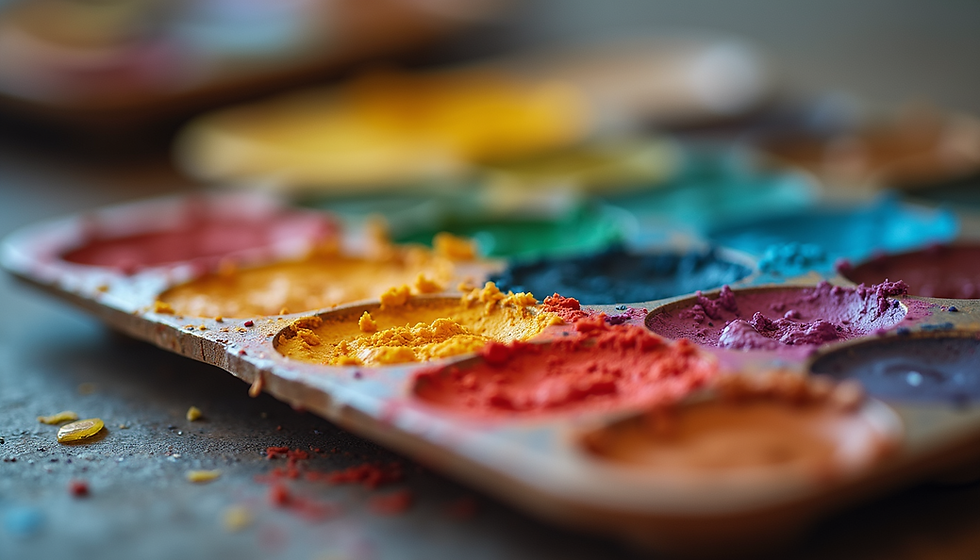How to Stay Inspired as an Artist During Creative Slumps
- Kriti Tiwari - lostloveforart

- Sep 29, 2024
- 4 min read

Every artist, no matter their skill level or experience, encounters creative slumps. Those moments when inspiration seems out of reach, and the blank canvas feels more like a daunting challenge than an exciting opportunity. If you’ve found yourself in this space, know that it’s completely normal—and temporary. While creativity might ebb and flow, there are plenty of ways to reignite your artistic spark. Here are some practical tips to help you stay inspired and keep creating, even during the most challenging slumps.
1. Take a Step Back and Rest
Sometimes, the most productive thing you can do is take a break. Constantly pushing yourself to create can lead to burnout, so it’s important to recognize when your mind and body need rest. Use this time to recharge by stepping away from your art for a bit. Take a walk, read a book, or simply relax without any pressure to produce. This pause often brings a fresh perspective when you return to your work.
2. Experiment with a New Medium
If your usual medium isn’t sparking joy, try something entirely new! If you’re a watercolor artist, dabble with acrylics or sketch with charcoal. Experimenting with different forms of art can free you from the expectations you’ve set for yourself and open the door to creativity in unexpected ways. Sometimes, just shaking up your routine is enough to get ideas flowing again.
3. Engage with Other Art Forms
Inspiration doesn’t always come from within; sometimes, it’s sparked by what you consume. Try engaging with art forms outside of your comfort zone. Watch films with stunning visuals, listen to music that moves you, or visit an art gallery (virtually or in person). Inspiration can be found in places you might not expect, and seeing how other artists express themselves can reignite your creative flame.
4. Set Small, Manageable Goals
When you’re in a slump, the pressure to create something “perfect” can be paralyzing. Instead of setting grand expectations, break your work down into smaller, manageable tasks. Give yourself the freedom to create something quick and simple, without worrying about the outcome. Sometimes, just getting back into the habit of making art—even if it’s a quick sketch or a practice piece—can lead to bigger, more inspired projects later.
5. Collaborate with Fellow Artists
Sometimes, working alone can contribute to the slump. Reach out to fellow artists and try a collaboration or participate in an art challenge. Sharing ideas and working together can create a sense of community and accountability, making the creative process more fun and less isolating. Seeing how others approach art may also inspire new ideas for your own projects.
6. Reflect on Your Artistic Journey
When you’re feeling stuck, it can help to reflect on how far you’ve come as an artist. Look through old sketches, paintings, or photographs of your previous work. Revisiting your progress can remind you of your growth and reignite the passion that first drew you to creating. It’s easy to forget how much you’ve improved over time, and this reflection might spark a desire to continue pushing your limits.
7. Embrace Imperfection
Creative slumps are often fueled by the fear of imperfection or failure. Let go of the need for perfection and allow yourself to create freely, without judgment. Every artist has pieces that don’t turn out as expected, but those "failed" attempts are a crucial part of the learning process. By embracing imperfection, you can create more freely, and in doing so, rediscover the joy that comes with artistic expression.
8. Set Up a Creative Routine
Establishing a regular creative routine can help you get through slumps by creating consistency. Dedicate a specific time each day or week to work on your art, whether you feel inspired or not. You don’t have to create a masterpiece every time—just showing up and making the effort can sometimes be enough to push through the block. Over time, this routine will help you keep your creative juices flowing.
9. Revisit Your Inspirations
Go back to the original sources of inspiration that sparked your artistic journey. Whether it’s a particular artist, a type of landscape, or a specific subject matter, reconnect with the things that once inspired you. Looking at old references or photos that excited you in the past can remind you why you started creating in the first place and help reignite that passion.
10. Give Yourself Permission to Play
Finally, remember that art doesn’t always have to be serious or structured. Give yourself permission to play! Try creating something silly, messy, or abstract without worrying about the final product. Sometimes, the best ideas come when you’re simply having fun with the process, not focusing on the outcome.
Final Thoughts
Creative slumps are a natural part of an artist’s journey, but they don’t have to hold you back. By embracing new experiences, experimenting with different techniques, and giving yourself space to rest, you can overcome these blocks and reignite your passion for art. Remember, inspiration isn’t something you have to chase—it often comes naturally when you allow yourself to create without pressure or expectation.
So next time you find yourself in a slump, use these tips to find your way back to inspiration and continue growing as an artist!



Comments